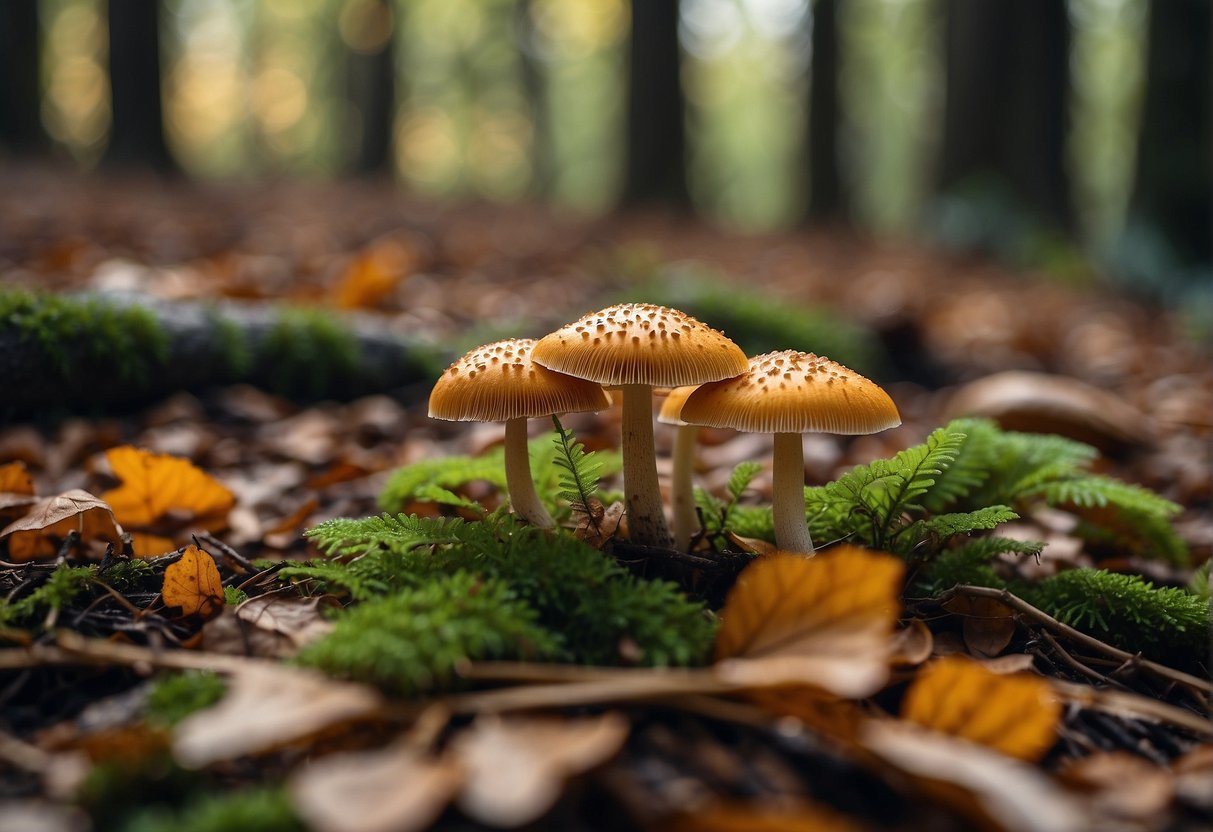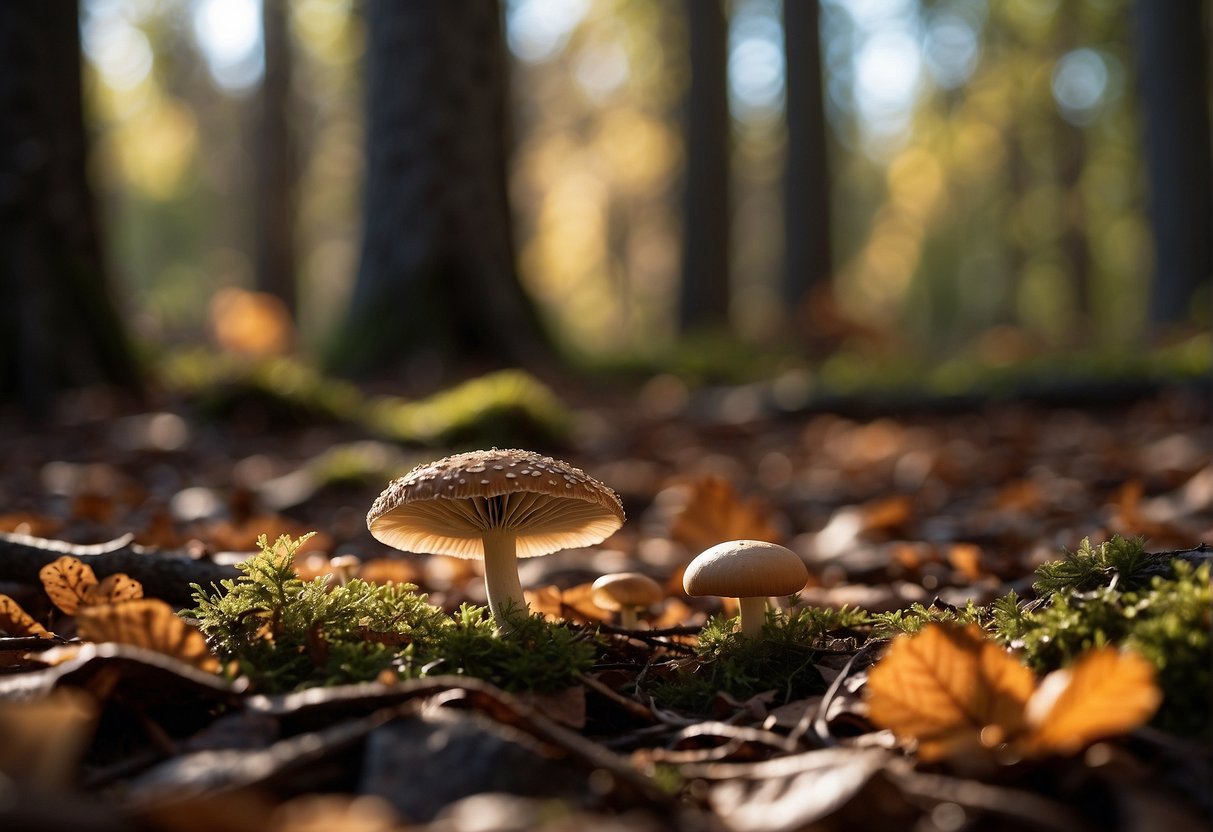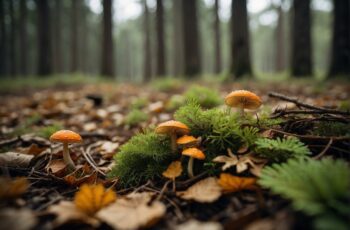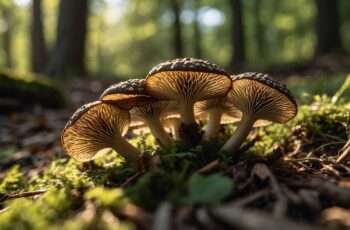As the leaves begin to turn and the air grows cooler, the forests come alive with a variety of fungi, presenting a wonderful opportunity for you to engage in mushroom hunting. Fall mushrooms offer a bountiful harvest for foragers, with the season boasting some of the most sought-after and delicious species. Whether you’re an experienced mycophile or new to the world of fungi, the autumn woods are a treasure trove waiting to be explored. Equip yourself with the right knowledge and you could be sautéeing, roasting, or adding a wild twist to your recipes with fresh, foraged mushrooms.

Understanding the types of mushrooms that flourish in the fall is the first step in a successful foraging expedition. Identifying edible mushrooms is both an art and a science, demanding meticulous attention to detail to ensure safety and a good harvest. It’s crucial to know which mushrooms are safe to eat, as some can look deceptively similar to their toxic counterparts. To maximize your foraging experience, aim to learn about the various species endemic to your region, their habitat preferences, and the subtle clues that differentiate edible fungi from those you should avoid.
Key Takeaways
- Engaging in mushroom foraging can enrich your autumn with unique culinary experiences.
- Proper identification of edible fall mushrooms ensures a safe and rewarding foraging adventure.
- Fall offers a diverse range of mushrooms, enhancing both outdoor activities and culinary endeavors.
Understanding Fall Mushrooms
As the crisp air of autumn sets in, forests become bustling ecosystems with wild mushrooms emerging in abundance. These fungi play pivotal roles in the ecosystem, from decomposing organic matter to providing sustenance.
Mushroom Lifecycle
Autumn marks a period of active fruiting for many mushrooms. The life cycle begins with spores which grow into a network of hyphae called mycelium—the actual organism. As temperatures drop and moisture increases, the fruit, which you commonly see as mushrooms, develops. This fruiting body consists of a cap, gills, stem, and sometimes pores or teeth under the cap, which release spores to begin the cycle anew. Notable fall varieties like the oyster mushrooms, rich in flavor, or the vibrant chanterelles are prime examples of mature autumn fungi ready for harvest.
Identifying Edible Varieties
Foraging for mushrooms is a rewarding experience, but correct identification is crucial for your safety. Edible varieties such as the hearty lion’s mane, found growing on hardwood trees, or puffballs, typically seen sprouting in fields, must be distinguished from their toxic counterparts. Look at the color, shape of the cap, and whether it has gills, pores, or a stem to help identify them correctly. Honey mushrooms, often found on fallen logs, are delicious when properly identified. Always consult a reliable guide, like this comprehensive fall mushroom identification resource, before consuming any wild mushrooms.
Ecological Roles
Within the ecosystem, mushrooms are crucial as decomposers. They break down dead organic matter, like fallen autumn leaves and wood, recycling nutrients back into the soil. Their intricate mycelial networks help create rich, fertile habitats for plants and other organisms. The delicate balance between these fungi and their habitat reinforces the importance of sustainable foraging practices. Remember, when you’re out in the woods, you’re not just a visitor; you’re part of the ecosystem.
Foraging and Harvesting Tips

Embarking on a mushroom foraging adventure this fall can be both rewarding and enjoyable. It’s essential to forage with knowledge and respect for safety, legality, and ecological sustainability.
Best Practices
When you set out to forage mushrooms, always carry a reliable field guide to help with mushroom identification. Begin with easily recognizable species and harvest only those you are 100% certain about. Avoid picking young, unopened mushrooms as they are harder to identify. Look for mushrooms in areas with moist soil, which often provide ideal growing conditions. Sustainable harvesting involves taking only what you need, cutting the stems rather than pulling out the entire mushroom, and scattering spores to encourage future growth.
Safety and Avoiding Look-alikes
The woods can be treacherous, and mushroom foraging is not without danger. Many edible mushrooms have poisonous look-alikes, such as the sought-after chanterelles and their deceptive twins, false chanterelles, or the infamous jack-o-lantern mushroom. Always cross-check the characteristics of the mushrooms you find with trusted resources. If in doubt, leave it out. Eating a single misidentified mushroom can lead to illness or worse.
Legal and Ethical Considerations
Before you forage, understand the land ownership and regulations in your chosen area. Many regions require a permit for foraging, and some places forbid it altogether to preserve delicate ecosystems. Respect private property and stay on marked trails. Practice ethical foraging by not overharvesting and by leaving enough mushrooms to ensure the species can continue to thrive in the wild. Your actions not only affect current populations but future generations of both mushrooms and foragers alike.
Culinary Uses and Recipes
As the leaves turn and the air cools, it’s the perfect time to harvest fall mushrooms and incorporate their rich flavors and varied textures into your cooking repertoire.
Preparing Fall Mushrooms
Cleaning: Start by gently brushing off any dirt from your mushrooms’ caps and stems with a soft brush or damp cloth. For mushrooms like chanterelles or hen of the woods, avoid rinsing as water can make them soggy.
Storage: Keep your mushrooms in a breathable container in the fridge to maintain freshness. If you have more than you can use, consider drying or freezing them for longer preservation.
Delicious Mushroom Dishes
Soups and Stews: Incorporate mushrooms like oyster or chanterelles to add depth to your soups and stews. They bring a meaty texture ideal for hearty, rustic dishes suited to the fall palate.
- Try a creamy mushroom soup highlighted with thyme and a splash of sherry for warmth and complexity.
Pasta and Risotto: Elevate your pasta dishes with sautéed mushrooms, adding both flavor and a satisfying chew.
- For a gluten-free option, toss through hen of the woods mushrooms with zucchini noodles and a sprinkle of parmesan.
Omelets and Frittatas: Start your morning with a mushroom omelet, utilizing the full-bodied flavor of oyster mushrooms to create a satisfying, protein-rich breakfast.
For those brisk autumn days, imagine wrapping your hands around a bowl of mushroom-infused comfort, be it a homemade mushroom pate or a moreish mushroom bourguignon. Seasonal fall mushrooms can transform ordinary dishes into flavorful feasts that celebrate the season’s bounty. Don’t skip on various mushroom recipes that are perfect for any outdoor adventurer looking to bring the taste of the wild to their table.


